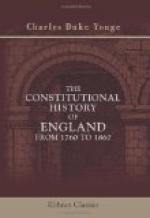[Footnote 267: As President of the Board of Trade. He afterward was raised to the Peerage as Lord Taunton.]
[Footnote 268: The second reading was carried in the House of Lords by 49 to 37.]
[Footnote 269: See “Peel’s Memoirs,” ii., 173.]
[Footnote 270: It has been observed that till the Corn-laws were repealed there had been no instance whatever of any person who had been engaged in trade becoming a cabinet minister. Since that time there have been several, some of whom only relinquished their share in houses of business on receiving their appointments, and some who are generally understood to have continued to participate in the profits of trade while members of an administration.]
[Footnote 271: Alison, quoting the General Report of the Census Commissioners, estimates the deaths caused by famine and the diseases engendered by it at the appalling number of 590,000, and states the sums advanced under different acts of Parliament to meet the emergency at L7,132,268.—History of Europe, vii., 274, 276, 2d series.]
[Footnote 272: The same statesman who has previously been mentioned as Lord Stanley, and whom the death of his father had recently raised to the House of Peers.]
[Footnote 273: In 1853 he said to Lord Clarendon, speaking of a new bill which he was pressing on Lord Aberdeen, then Prime-minister, “I am for making it as Conservative as possible, and that by a large extension of the suffrage. The Radicals are the ten-pound holders. The five-pound holders will be Conservative, as they are more easily acted upon.”—Life of the Prince Consort, ii., 503. It was the same idea that inspired some of the details of the Reform Bill subsequently passed by Lord Derby’s third ministry.]
[Footnote 274: “Life of the Prince Consort,” iv., 395.]
[Footnote 275: “Life of the Prince Consort,” v., 56.]
CHAPTER XIII.
Dismissal of Lord Palmerston.—Theory of the Relation between the Sovereign and the Cabinet.—Correspondence of the Sovereign with French Princes.—Russian War.—Abolition of the Tax on Newspapers.—Life Peerages.—Resignation of two Bishops.—Indian Mutiny.—Abolition of the Sovereign Power of the Company.—Visit of the Prince of Wales to India.—Conspiracy Bill.—Rise of the Volunteers.—National Fortifications.—The Lords Reject the Measure for the Repeal of the Paper-duties.—Lord Palmerston’s Resolutions.—Character of the Changes during the last Century.
The frequency of ministerial changes at this time has already been mentioned, and the first of them took place at the beginning of 1852, under circumstances which throw some light on a question which has never been exactly defined—the duty of the different members of a cabinet to one another, to the Prime-minister, and to the sovereign.




